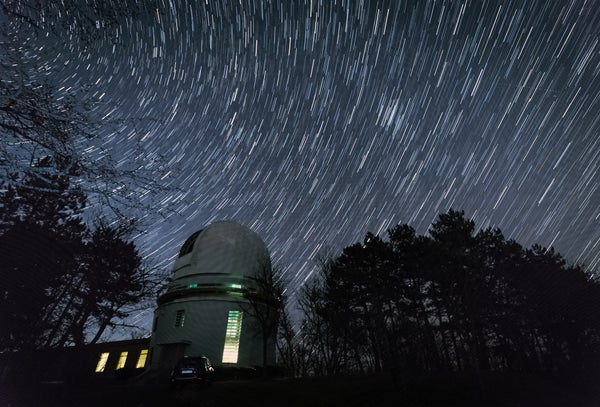When purchasing a new phone or tablet, it is common practice to select the best technology that fits your needs within the available budget. This is also the strategy adopted by our research team at the Galileo Project, a new initiative to image unidentified aerial phenomena (UAP) like those reported by the Office of the Director of National Intelligence (ODNI) to the U.S. Congress on June 25, 2021.
To my amusement, I recently came across an online retailerthat would allow us to “add to cart” a one-meter telescope for half a million dollars. Fortunately, cheaper telescopes are all that is needed for surveying the sky at the proper resolution to identify UAP.
Under typical weather conditions, Earth’s atmosphere is opaque to infrared light beyond a distance of about 10 kilometers or less. Resolving a feature the size of a cell phone on the surface of a UAP at that distance requires a telescope diameter on the order of 10 centimeters. Having a few such telescopes on a given site will allow us to monitor the motion of an object in three dimensions. These telescopes could be supplemented by a radar system that would distinguish a physical object in the sky from a weather pattern or a mirage.
On supporting science journalism
If you're enjoying this article, consider supporting our award-winning journalism by subscribing. By purchasing a subscription you are helping to ensure the future of impactful stories about the discoveries and ideas shaping our world today.
If UAP are solid objects, they should heat up as they rub against air at high speed. The surfaces of objects that move in air faster than sound, such as supersonic airplanes or space rockets, are heated by hundreds of degrees. I calculated that the infrared glow of fast objects above a meter in size, supplemented by the heat from shockwaves in the air around them or an engine they carry, should be detectable with infrared sensors on telescopes out to the desired distance.
The data from a system of optical, infrared or radio telescopes will be fed to state-of-the-art video cameras linked to software that will filter out objects of interest for the telescope to track. If a bird flies above a common astronomical observatory, it will be ignored. The Galileo-Scopes will track it. Human-made drones or airplanes might be of great interest to some residents of Washington, D.C., but they are as uninteresting as birds for the Galileo Project.
My student Amir Siraj and I calculated that the number of UAP described in the ODNI report corresponds to about one object per hundred thousand square kilometers per year (with large uncertainties up to a factor of 100). This is well below the rate of unidentified objects from cell phone photographs or civilian eyewitness testimonies, implying that many of these unofficial sightings may have mundane explanations. Millions of cell phones with millimeter-size apertures are inferior to what Galileo proposes: a much smaller number of optimized telescope systems with apertures 100 times larger that are designed to rapidly track UAP.
The iceberg of classified reports‑of which only the tip has been exposed publicly‑may contain higher-quality images than those released to the public. Galileo’s goal is to capture new crisp images with better instruments than have ever been used by civilians. The full data set from the project will be open, whereas much of the data associated with the ODNI report is classified because it was obtained by government-owned sensors. Because the sky is not classified, Galileo-Scopes will operate just like common astronomical telescopes‑except that they will focus on nearby objects. We aim to change the intellectual landscape of UAP studies by bringing them into the mainstream of credible scientific inquiry.
In my book Extraterrestrial, published half a year ago, I argued that bringing the search for technological relics into the mainstream of astronomy would attract new funds and young talent to science. In recent weeks, this forecast became a reality. The Galileo Project has attracted millions of dollars from private donors and thousands of commitments from volunteers who offered to contribute their time and resources. Given the low incidence of UAP reported by ODNI, however, the project will need hundreds of telescopes to find UAP over a few years. That represents an order of magnitude more funding than we have collected so far.
With good enough data, extraterrestrial technologies can be distinguished from terrestrial technologies or natural objects. The Galileo Project will attempt to obtain this data from both UAP and unusual interstellar objects like `Oumuamua.
If prehistoric cave dwellers were to discover a cell phone, they would initially assume it to be a shiny rock of a type never seen before. But this might be the beginning of their learning experience. By pressing buttons on this weird rock, these early humans would record voices and images.
Similarly, the strange `Oumuamua has been interpreted as a new type of asteroid, such as a frozen chunk of pure hydrogen or nitrogen. But what if high-resolution images of such a weird object revealed buttons? It could encourage us to learn more by landing on the surface, just as the OSIRIS-REx craft recently landed on the asteroid Bennu. Here’s hoping that astronomers will be open-minded enough to check.
This is an opinion and analysis article; the views expressed by the author or authors are not necessarily those of Scientific American.
